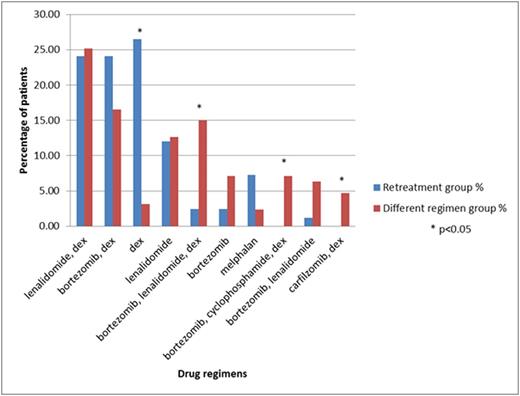Abstract
Introduction: Clinical trials have suggested that retreatment with multiple myeloma (MM) therapy provides clinical benefit (Mohty 2012), however, little is known about real-world utilization and outcomes of retreatment. Information from this analysis will help to better understand the real-world impact of retreatment for management of first MM relapse.
Methods: A retrospective claims analysis of commercial and Medicare Advantage patients aged 18 years in the Optum Research Database. To be included, patients had to have ≥ 2 medical claims ≥ 30 days apart with an MM diagnoses (ICD-9 =203.00) between 01 Jan 2009 and 31 Dec 2013 (study period); ≥ 2 lines of therapy and no evidence of hematopoietic cell transplant during the study period and data available for 1 year prior to index date and ≥ 6 months post index date. The date of the first claim of an NCCN recommended MM treatment during the study period was considered the index date. All MM treatments identified < 30 days of the index date were considered part of first line of therapy. An algorithm was developed for identifying subsequent lines of therapy. A new line of therapy was identified when there was a switch to a new agent < 180 days of discontinuation of the prior line of therapy or retreatment with the same treatment ≥ 180 days of discontinuation with previously used agents. Additionally, patients had to be treated for relapse MM defined according to lines of therapy when 1) there was an active line of therapy ≥ 60 days long and there was a gap of ≥ 180 days from the end of the line of active therapy to the start of the next line of active therapy or 2) there was a line of therapy ≥ 180 days long and a different treatment was started, with or without a 180-day gap between discontinuation of the prior line and start of the subsequent line of therapy . The data evaluated in the analysis included baseline demographics, Quan-Charlson comorbidity scores, line of therapy, and clinical outcomes, including treatment duration and overall survival. Data were analyzed using chi-square and t-tests to compare patients with retreatment vs. treatment with a different regimen for first relapse MM (i.e. second-line therapy).
Results: A total of 252 patients (mean age: 70 yrs; 48% male) were identified as having second-line treatment for relapse MM; 90 patients (35.7%) were retreated with the same regimen and 162 (64.3%) patients were treated with a different regimen. Mean Quan-Charlson comorbidity scores were equal between the two groups (p=0.585). Among the retreatment group, 48.2% were treated with monotherapy for first-line, compared to 25.2% of the different regimen group (p-value < 0.001). Dexamethasone (dex) monotherapy, bortezomib plus dex, and lenalidomide plus dex were common regimens used in retreatment, see Figure 1. Lenalidomide plus dex was also commonly used as a different regimen for second-line treatment. Additionally, dex monotherapy was significantly less likely to be used as a new therapy compared to being used as retreatment for second-line therapy (p<0.05). Conversely, bortezomib plus lenalidomide plus dex was significantly more likely to be used as a new therapy compared to being used as retreatment for second-line treatment (p<0.05). The mean length of relapse line was 161 days in the retreatment group versus 212 days in the different regimen group (p-value 0.067). The incidence rate of death was 13 events (1.43 events per 10,000 person-days of follow-up) in the retreatment group versus 22 events (1.51 events per 10,000) in the different regimen group (p=0.895).
Figure 1: Second-line Treatment Regimens among Patients who Received the Same Regimen (Retreatment) vs. a Different Regimen for the Treatment of First-Relapse MM\s
Conclusions: In this analysis, approximately one-third of patients were retreated with the same treatments in first-line and second-line of therapy. Patients who were retreated with the same regimen tended to have shorter duration of second-line therapy. However, risk of death did not appear to differ between the two groups. This real-world analysis suggests that retreatment in second-line may affect the time to next treatment, but may not negatively impact the overall risk of death.
Reference: Mohty B, El-Cheikh J, Yakoub-Agha I, et al. Treatment strategies in relapsed and refractory multiple myeloma: a focus on drug sequencing and 'retreatment' approaches in the era of novel agents. Leukemia 2012; 26: 73-85.
Lal:Optum: Employment. Chastek:Optum: Employment. Blauer-Peterson:Optum: Employment. Maiese:Janssen Scientific Affairs, LLC: Employment.
Author notes
Asterisk with author names denotes non-ASH members.


This feature is available to Subscribers Only
Sign In or Create an Account Close Modal